Geography Pages
Maps of Russia
All boundaries, and borders of countries, are approximate
The territory controlled by a king or people varied from time to time, and was often disputed by other peoples. An approximation to the modern coast-line is generally used in the maps.
- Modern Russia and the World
- Kievan Rus, AD 1054 (at the Death of Yaroslav the Wise)
- Muscovy, the Tartars, and the Teutonic Knights, AD 1250
- The Mongol Empire
- Go here for maps of later Russia
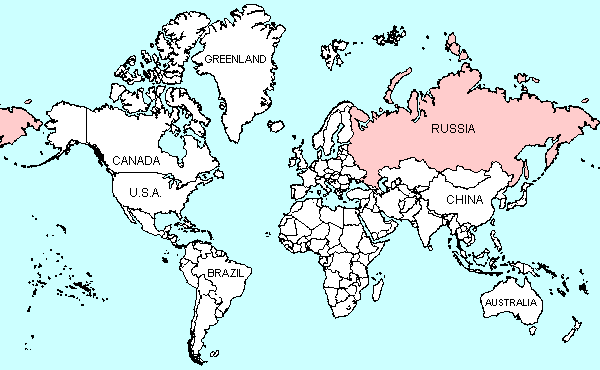 |
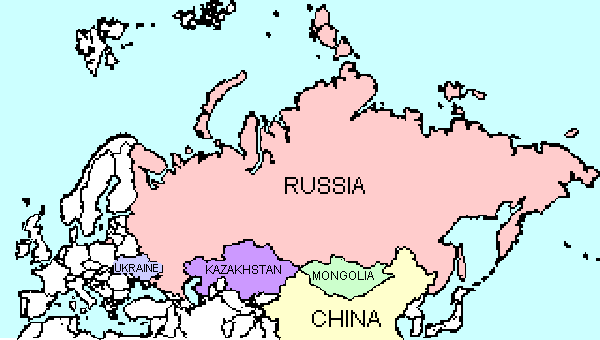 |
The land we tend to think of as Russia is one of the largest countries in the world. It lies across both Europe and Asia, with the Ural Mountains dividing the country north-south between the two continents. There is a difficulty when drawing maps, in that it is not possible to represent accurately distances as measured on the spherical surface of the earth by distances on a two-dimensional plane. Most maps make the Bering Strait between Alaska and the East Cape of the USSR look quite large. In fact, the Bering Strait at its narrowest point is only 53 miles wide.
At present the preferred name for the region is the Union of Soviet Socialist Republics, U.S.S.R, or the Soviet Union. However, in recent decades the Union has disintegrated somewhat as some of the states have disengaged from the Union. As a result, the map of the current USSR shows one small region (Kaliningrad) on the Baltic coast, which is separated from the rest of the Union by the Estonian, Latvian, and Lithuanian Soviet Republics
![]()
Most of the early history of Russia involves the Western (European) part of the country, so maps for the various periods often show only the western one third of the country. The earliest recorded history took place, not in what is now Russia, but in what is now Ukraine.
| Map of Kievan Rus and Europe, ca. AD 1050 |
|---|
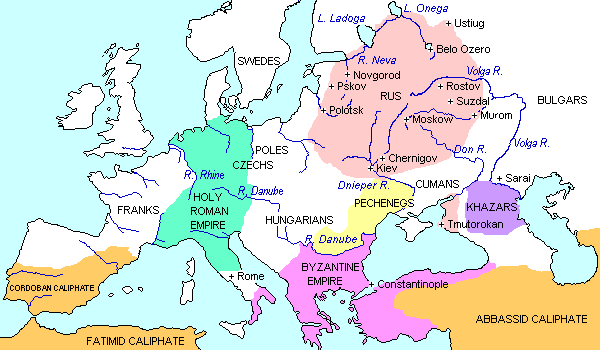 |
| During the ninth century the Varyags (Vikings) invaded Europe from the region of Norway and Sweden, using the rivers as their primary means of transport. One group settled first in Novgorod, and later in Kiev, and dominated the local Slavic population. The resulting tribes were known as the Kievan Rus. Although the Rus were able to travel by river as far as Constantinople and the Byzantine Empire, expansion and settlement to the south was blocked by invading eastern tribes such as the Khazars, Cumans, Pechenegs. A small settlement at the mouth of the River Don was all the Rus could hold in the south. In 911 and 945 the leaders of the Rus signed treaties with the Byzantine Empire to allow trading in furs and slaves Princess Olga of Kiev was baptized in 954, visited Constantinople, and is known in Russia as "The Apostle to the Russians" Olga's son Svyatoslav remained a pagan and killed several of his brothers. He attacked the Byzantine Empire, but was defeated, and while he was retreating he was killed by the Pechenegs. Vladimir, the illegitimate youngest son of Svyatislav, became a Christian in 988-989, married Anna, the sister of the Byzantine Emperor Basil II, and established the Russian Church as part of the Byzantine Church, rather than the Roman Church. At the time of his marriage to Anna he had already had several wives, producing 12 sons, and about 500 concubines. Vladimir died in 1015 fighting his son Yaroslav who had rebelled in Novgorod. His son Svyatopolk the Damned killed three of his brothers, including Boris and Gleb who were Christians, but was defeated in turn by his brother Yaroslav the Wise, prince of Novgorod. Yaroslav (lived 980-1054) moved to Kiev in 1019, and codified the earliest recorded laws of the Rus, known as the "Russkaia Pravda". During his reign he had contact with England (the two sons of Edmund II took refuge with him when Canute invaded England) and with most of the kings and princes of Europe. His daughter Elizabeth married Harald III Hardraade of Norway, Anastasia married Andrew I of Hungary, and Anna married Henry I of France. His sons married Polish, German, and Greek wives. He divided his kingdom between his five surviving sons, with instructions for how the succession was to be maintained, but that system did not last very long. In 1169 Yaroslav's great-great-grandson Andrew invaded from the north and took Kiev, but remained as a ruler in the north. The center of power moved to Novgorod, the country split into warring principalities, and Kiev lost its position of importance. |
|
| The Byzantine Empire was torn by internal strife, and under pressure from foreign invaders. Although they claimed southern Italy as part of their Empire, they were probably not in control of the territory, and in 1053 Robert Guiscard (1015-1085), a Norman noble, invaded and founded his own kingdom in southern Italy. In 1054 the disagreements between the Eastern Orthodox and the Western Roman Churches came to a head, and the great Schism between East and West ensued. The Byzantine Empire continued to lose territory until it was finally overrun by the Turks in 1453 |
|
| In 1046 Henry III was crowned Holy Roman Emperor in Rome, succeeded by his son in 1053 | |
| The Moslem Arab invasions of Africa had taken all of the northern coastlands of Africa, and gained a foothold in the Iberian peninsular (what is now Spain and Portugal). They were being successfully repulsed by the kings of Castille and Navarre. However, in the East the Seljuk Turks were coming to power against Armenia; they would eventually invade and destroy the Byzantine Empire |
| Map of Muscovy and Europe, ca. AD 1250 |
|---|
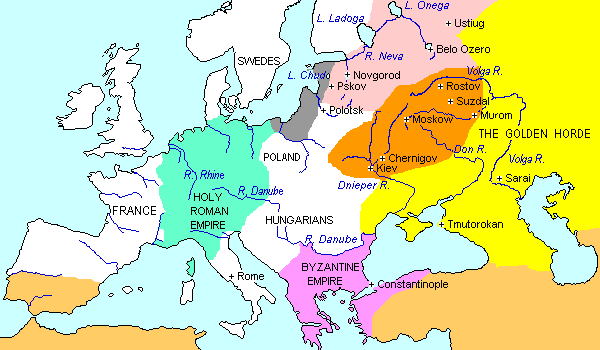 |
| Tartar was a name used in Europe for the groups of Mongols and other nomadic tribes who started to move westwards from their original homeland in central Asia in the thirteenth century. In 1206 a young Mongolian leader, Temujin, fought his way to power over the Mongol tribes, and took the name Ghenghis and the title "Khan" (leader, equivalent to Emperor). By a series of brilliant military campaigns Ghengis Khan conquered northern China, most of central Asia, Turkistan, and the southern parts of Russia. In 1251 his grandson Kublai Khan united north and south China under his rule, and founded the Mongol Yüan dynasty in 1259. Ghenghis Khan was killed in 1227, and was succeeded by four sons. Ogodai Khan took control of the western steppes, Jagatai Khan took east Turkhistan, Juchi (who also died in 1227) took west Turkhistan. Juchi was succeeded by his son Batu Khan, who led the Golden Horde westwards, consolidated Mongol control of most of Russia and founded the Kipchak Empire. In 1242 Batu Khan established Sarai as his stronghold. The Mongols do not seem to have had the concept of ruling as a settled conquering nation. They allowed conquered peoples to retain the social structures they had had, except that they had to supply the Mongols with gold, horses, and women. In the case of Russia, the Khans allowed the princes of the various principalities to continue ruling as vassal princes. The Khans reserved the right to appoint the "Grand Duke", and the princedom of Muscovy, centered on Moscow, became the most important of the conquered states. Batu Khan died in 1255 and was succeeded by his brother Berke Khan, who became a Muslim. Full conversion of the Golden Horde to Islam was carried out by Uzbek Khan (1312-1342), but they did not force their conquered peoples to convert - the Russians were allowed to remain Christian so long as they paid their taxes. Novgorod and the more northerly regions managed to stay more or less free of the Tartars. |
|
| Most of Russia was overrun by the Tartars of the Golden Horde. This meant that there were frequent raids and pillaging by the Tartars. The Princes of the various regions of Russia had to pay tribute to the Khan of the Golden Horde. The Principality of Muscovy, centered on Moscow, became the most important of the Principalities, and the Khans gave the princes of Moscow the rank of "Grand Duke". The "Tartar Yoke" held Russia until 1480, when Ivan the Great broke free and refused to pay tribute. |
|
| The Principality of Novgorod was relatively free from invasion, and continued to spread northwards slowly. Alexander Nevski (1220-1263) defeated the Swedish invaders at the Battle of the Neva in 1240, became prince (Grand Duke) of Novgorod in 1241, and defeated the Teutonic Knights at Lake Chud (Lake Peipus) in 1242. He collaborated with the Mongols, and was made Grand Prince of Kiev, Vladimir, and Novgorod. | |
| The Teutonic Knights were members of a German religious military order which was founded in 1190 as part of the Hospitalers, but became a separate Order in 1198. They decided that they would carry on a "crusade" in northern Europe rather than the Holy Land. Their idea of evangelism was to invade the lands of pagans (such as the Prussians), and Eastern Orthodox peoples (such as the Rus), build castles, and establish military rule. Their advance into Russia was halted by Alexander Nevski, who drove them out in 1242. In 1410 they were defeated by (Roman Catholic) Lithuanian and Polish armies at the Battle of Tannenberg, and began to lose power in the region. | |
| During this period Islam was losing ground in the Iberian peninsular, but was still advancing on Byzantium in the East. The Tartars became Muslim in the early fourteenth century. |
| Map of the Mongol Empire |
|---|
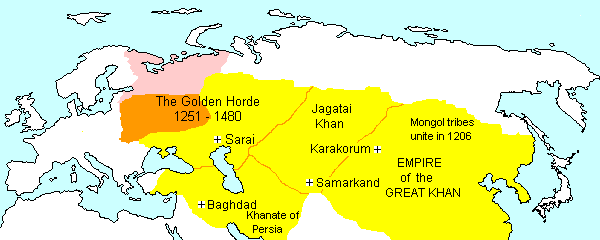 |
![]() Go here for the History of the period.
Go here for the History of the period.
Copyright © 1999 Shirley J. Rollinson, all Rights Reserved